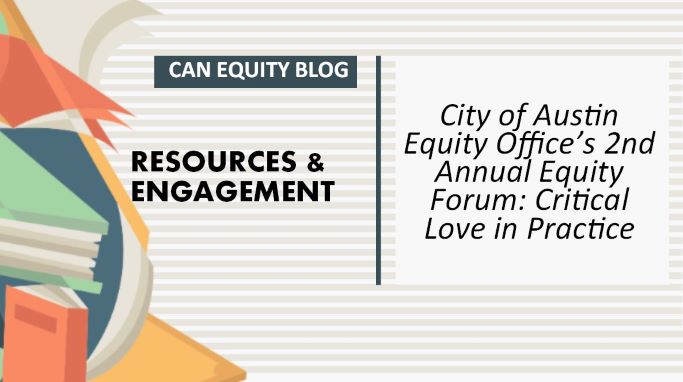RESOURCES & ENGAGEMENT: City of Austin Equity Office’s 2nd Annual Equity Forum: Critical Love in Practice

2nd Annual Equity Forum: Critical Love in Practice
Hosted by City of Austin’s Equity Office
As we celebrate Martin Luther King Jr. Day and move into Black History Month, it seems fitting to make this month’s Equity Blog about local race equity work that is being undertaken. If you look through the CAN Dashboard you will see disparate outcomes for poverty, homelessness, chronic illness, jail bookings, education and voting. The population in Travis County is 8% Black and 34% Hispanic/Latino. However, nearly 20% of people in poverty and 35% of the homeless population in Travis County are black. Nearly 60% of the children living in poverty in Travis County are black and brown. Black people are 2.8 times more likely to get booked into jail than their white counterparts. Local efforts to address institutional racism are thus quite necessary and critical.
I attended the City of Austin’s 2nd Annual Equity Forum January 18, 2020. The theme this year was “Critical Love”. The forum began with the City of Austin’s Chief Equity Officer Brion Oaks sharing information about the history of racism in Austin and the importance of centering race in equity work. After the introduction and level setting with Brion, A panel that included Paula Rojas, Carmen Llanes Pulido, Dr. Stephanie Hawley, and Chris Harris discussed the race equity work they are doing in the community and why “critical love” is so important.
My understanding of “critical love” after the panel presentation is that we must walk in and speak our truth even though doing so causes discomfort for us or others. When we speak out, we feel like we are rocking the boat, and for us to challenge institutions can feel very risky. But, not saying or doing anything has the effect of maintaining the status quo. Another thing I took away from the panel is that it is so important to approach this work out of love. When we approach this work in hate, we aren’t showing up as our best selves and could potentially worsen the problem we are trying to fix. It reminded me of a quote from Martin Luther King Jr. “Darkness cannot drive out darkness; only light can do that. Hate cannot drive out hate; only love can do that.”
The last presentation before breakout sessions was the keynote speaker M. Adams who spoke about changing the mind frame in which we approach equity issues in order to make a greater impact. Often when doing race equity work, we treat a symptom instead of the real issue. We try to fix the people who aren’t being served well by institutions, instead of trying to fix the institutions. M. Adams suggested that in order to change the system we must have a paradigm shift and start comparing current day outcomes to the times of colonization. They pointed out the similarities between a land being colonized and the current state of our society. The purpose of colonization was to acquire land of indigenous people and use them for cheap labor to build a system that benefits those that colonized the land. To this day we still get free labor through the prison systems which we know is disproportionately filled with black and brown people.
Adams also suggested that the only way to stop colonization is through power. M.Adams followed that thought “I’m not interested in changing people’s values and beliefs; I’m interested in changing the power that allows those values and beliefs to affect me.” To me that suggests two things: (1) change in race equity cannot be dependent on one individual changing their mindset, it must come from changing the system and institution; and (2) the race equity issue is a power issue. If we want to make impactful change in race equity, the best thing we can do is help those most affected harness the power that they have. Our community has focused a lot time and resources on training individuals. Many see this as great progress. M. Adams suggests that while training can be beneficial, it doesn’t change the system.
There are ways to get more involved with advancing race equity in Austin. The Equity Office has a dashboard that explains their efforts and how to get involved. If you find race equity to be a priority of yours or your organization, consider following this example. Analyze your programs, initiatives, and policies and see if they empower the very people you are trying to help. What is one way you can help advance race equity for your, organization? CAN has resources to help organizations and individuals do just that. If you would like to explore tools that can help explore race equity, check out our Cultural, Competence, Diversity and Inclusion toolkit. The toolkit includes information and resources for better serving people of different races/ethnicities, as well as information and resources for better serving veterans, individuals who are LGBTQ+, seniors, youth, individuals who are LEP, immigrants, etc.
Jelina Tunstill
CAN Program Coordinator